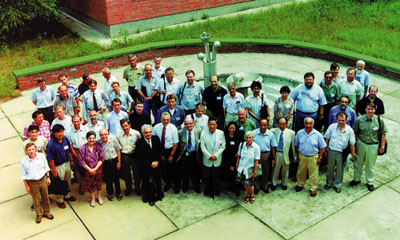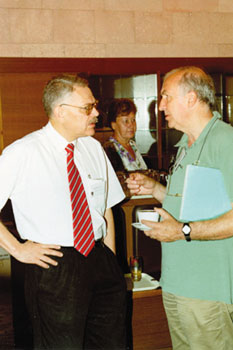Understanding most of what happens in high-energy particle scattering should be easy, but it isn’t. A recent international conference underlined a traditional dilemma.

While we claim to understand more and more about how elementary particles interact, modern particle physics is increasingly being characterized by bigger and bigger experiments, which are searching for smaller and smaller effects. Most of what happens in high-energy scattering processes is put to one side and is deemed unfashionable. However, what is thought to be unfashionable by some is not necessarily uninteresting to everyone.
The largest single such process is elastic scattering – where the incoming particles bounce off one another. However, even this straightforward process is difficult to understand quantitatively. Central to this physics is the concept of the pomeron mechanism. What exactly is the pomeron? Our current understanding of these processes was summarized in an article by Sandy Donnachie in the April 1999 issue of CERN Courier.
Every two years, dedicated enthusiasts of this physics meet for the International Conference on Elastic and Diffractive Scattering. Initiated in 1985 by B Nicolescu and J Tran Thanh Van, the first meeting was held in the Chateau de Blois, France – hence the series has earned the name Blois Workshops. The latest Blois meeting was held at Protvino, near Moscow, this summer.
Fundamental dilemma
There appears to be a dilemma that involves our understanding of fundamental processes. The general features of the bulk of high-energy scattering processes are difficult to reconcile with quantum chromodynamics (QCD) – the field theory of quarks and gluons. Reports at major physics conferences around the world say that quantum chromodynamics “works perfectly well at high energies”. This is true. However, it has to be qualified by insisting on high-momentum transfers.
On the other hand, diffractive and elastic scattering are characterized by small momentum transfers where traditional QCD approaches are difficult. Nevertheless, theoreticians have tried bravely to understand the pomeron through QCD. After lengthy and cumbersome calculations, Russian theorist L Lipatov and his collaborators managed to obtain some insight into the “hard” pomeron.
Fortunately this arrived in time for the first results from the HERA electron-proton collider at DESY. The results indicated that, reaction rates for processes that involved the absorption of a virtual photon by a proton, grow in energy much faster than, say, proton-proton reaction rates.
Many physicists believe that the hard pomeron is responsible for this rapid growth. With the situation becoming more complicated with more detailed QCD analysis, the elastic-diffractive community came to the Blois workshop in Protvino.
Results from H1 and ZEUS
Centre stage at the workshop were recent results obtained from the two major collaborations at HERA: H1 and ZEUS. Complemented by hard-diffraction studies at Tevatron, these results confirmed general trends that had been observed previously and had posed a number of problems.
- Why do reaction rates grow faster with energy when the virtual photon becomes even more virtual?
- Is there a new, hard pomeron that is dependent on the particular scattering process?
- Are there distinct pomerons (hard and soft) or is there one single pomeron that manifests itself in different ways depending on the kinematics?
Theoreticians presented a range of possible answers. N Tyurin (IHEP, Protvino), in the framework of a specific approach (U-matrix), argued that unitarity allows new possibilities (antishadowing) and that preasymptotic behaviour may mimic fast energy growth. A Kaidalov (ITEP), using the ITEP-Orsay quasi-eikonal approach, developed an interesting scenario of “undressing” the pomeron with a highly virtual photon. E Predazzi (INFN, Torino) gave an original view on ways in which one can detect unitarity effects in elastic and diffractive scattering. A young theoretician from IHEP, A Prokudin, insisted that all of the data from HERA do not rule out the “good old soft pomeron” and that there is no need for anything else.
This also found support in the excellent talk by M Kienzle (CERN), which was devoted to photon-photon interactions at LEP. The first experimental results on the total cross-sections were summarized.
However, the hard pomeron was not discredited at the conference. The discrepancies that were uncovered initiated a useful impromptu discussion session. One of the subjects that was covered was “What is the pomeron?” In the course of the discussion session it was realized that, very often, the same term is used to designate different contents.

Pomeron and odderon conclusions
The status of the perturbative pomeron was summarized in the mini-review on BFKL by one of the authors of this mechanism, E Kuraev from JINR (Dubna). In many cases the results are too preliminary for immediate use (or misuse) in phenomenological models. The work on this subject is, without doubt, extremely important.
Another feature of this physics is the odderon, which supplements the main pomeron mechanism and accounts for differences between, for example, proton-proton and proton-antiproton scattering. A special session devoted to the still elusive odderon was led by one of its most enthusiastic advocates, B Nicolescu.
The theoretical legitimacy of the odderon comes from recent QCD calculations. There are good prospects for its detection in exclusive processes at HERA. Drawing odderon conclusions from the latest CERN proton-antiproton diffractive scattering experiments seems very difficult and model dependent.
Further studies
High-energy elastic and diffractive studies are needed to resolve the picture. Included in these studies are the TOTEM project for CERN’s LHC collider, presented by S Weisz (CERN), and Brookhaven’s RHIC heavy-ion collider, presented by S Nurushev (IHEP, Protvino). Some specialized projects related to polarization phenomena were reviewed by A Krisch (Michigan).
The need for further experimentation at the LHC was also advocated by A Martin (CERN), to test the saturation of the fundamental Froissart bound on high-energy scattering behaviour and to see if dispersion relations continue to hold true or a breakdown of locality occurs.
The overall impression gained from the Protvino workshop is that elastic and diffractive scattering, despite being unfashionable, is very interesting and has a direct bearing on the most fundamental problems of this physics. A great variety of differing opinions were expressed (often mutually contradictory) and even disputes took place. This suggests a healthy future for research into elastic and diffractive scattering.







